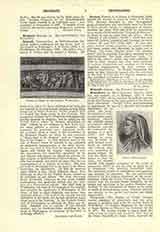

Brumidi, CONSTANTINO, an Italo-American historical painter, celebrated for his fresco work in the Capitol at Washington, b. at Rome, 1805; d. at Washington, February 19, 1880. His father was a native of Greece and his mother a Roman. He showed his talent for fresco painting at an early age and painted in several Roman palaces, among them being that of Prince Torlonia. Under Gregory XVI he worked for three years in the Vatican. The occupation of Rome by the French in 1849 apparently decided Brumidi to emigrate, and he sailed for the United States, where he became naturalized in 1852. Taking up his residence in New York City, the artist painted a number of portraits. Subsequently he undertook more important works, the principal being a fresco of the Crucifixion in St. Stephen’s Church, for which he also executed a “Martyrdom of St. Stephen” and an “Assumption of the Virgin”. In 1854 Brumidi went to the city of Mexico, where he painted in the cathedral an allegorical representation of the Holy Trinity. On his way back to New York he stopped at Washington and visited the Capitol. Impressed with the opportunity for decoration presented by its vast interior wall spaces, he offered his services for that purpose to Quartermaster-General Meigs. This offer was accepted, and about the same time he was commissioned as a captain of cavalry. His first art work in the Capitol was in the room of the House Committee on Agriculture. At first he received eight dollars a day, which Jefferson Davis, then Secretary of War of the United States, caused to be increased to ten dollars. His work attracting much favorable attention, he was given further commissions, and gradually settled into the position of a Government painter. His chief work in Washington was done in the rotunda of the Capitol, and included the apotheosis of Washington in the dome, as well as other allegories, and scenes from American history. His work in the rotunda was left unfinished at his death, but he had decorated many other parts of the building. In the Catholic Cathedral of Philadelphia he pictured St. Peter and St. Paul. Brumidi was a capable, if conventional painter, and his black-and-white modeling in the work at Washington, in imitation of bas-relief, is strikingly effective.
AUGUSTUS VAN CLEEF

